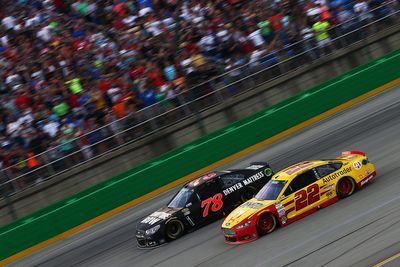NASCAR no doubt made the right move in reducing the downforce in the Sprint Cup Series racecars this weekend at Kentucky Speedway. Drivers seem to be in favor of
But there are some downsides. For one, the change came late and kind of suddenly. While it had been rumored for several weeks, the rules change this past weekend did not come about in time for Goodyear (who had already tested tires at Kentucky with the older package) to make a tire
NASCAR has had a propensity lately to respond to
NASCAR also made a perplexing announcement at the same time as the Kentucky and Darlington
Consider this about Saturday's race. Who has been struggling before and suddenly did well? Joe Gibbs Racing cars took four of the top five positions (including the win), after struggling for speed all year. The abysmal Roush-Fenway Racing trio of teams finished 11th (Ricky Stenhouse Jr.), 13th (Trevor Bayne), and 16th (Greg Biffle) - that certainly gives their stable a shot in the arm.
And who of 1.5-mile stalwarts struggled? 2015 Cinderella story Martin Truex Jr. ran in the top 10, but dropped out of it after halfway in the race and only managed to get back to 17th. Kevin Harvick cracked the top 5 midway thru the Quaker State 400, but hovered in the back of the top 10 late and finished 8th. Jimmie Johnson struggled outside the top 20 for the middle third of the
Jeff Gordon's 2015 farewell tour has seen him struggle most weeks. Many think this rules change should work in his favor, but the No. 24 did not lead a lap and placed 7th. Tony Stewart has been outspoken about his inability to adjust to how the 2014-15 Sprint Cup cars race. He has had a horrible season and even the new rules package didn't save him Saturday night. He got caught up in someone else's crash while running outside the top 20. He was never a factor.
At least for now, NASCAR plans on returning to the previous rules package for the 1.5-mile tracks in the Chase in the fall. This likely means that Truex Jr., Johnson, and Harvick will be the threats yet again. And the racing action in the Chase may not be so
NASCAR made the right move in adjusting the rules package and needs to continue looking at ways to improve the on-track product. Putting the steering wheel back in the drivers' hands, instead of all the way inside the engineers' computers, will undoubtedly bode well for the future of the sport. But do not place your faith completely in this low-downforce setup as the savior of today's NASCAR racing. We have seen just one race and NASCAR and its teams may still be far off from really diagnosing and fixing the sport's passing problem.

